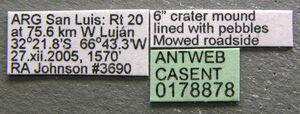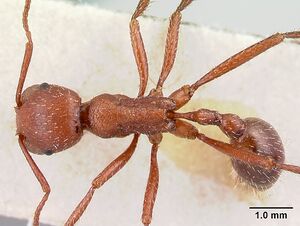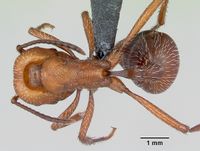Pogonomyrmex pencosensis
| Pogonomyrmex pencosensis | |
|---|---|

| |
| Scientific classification | |
| Kingdom: | Animalia |
| Phylum: | Arthropoda |
| Class: | Insecta |
| Order: | Hymenoptera |
| Family: | Formicidae |
| Subfamily: | Myrmicinae |
| Tribe: | Pogonomyrmecini |
| Genus: | Pogonomyrmex |
| Species group: | cunicularius |
| Species: | P. pencosensis |
| Binomial name | |
| Pogonomyrmex pencosensis Forel, 1914 | |
Unusual for a Myrmicinae, this species has a queen caste that is very similar to workers in its morphological features.
Identification
Johnson (2015) - Worker Within the P. cunicularius-group, the combination of: (1) in profile, apex of petiolar node weakly rounded to angulate, (2) inferior propodeal spines acuminate, (3) superior propodeal spines long, length notably greater than distance between their bases, (4) first gastral tergum moderately coriarious, dull to weakly shining, (5) sculpturing on dorsum of promesonotum and posterior surface of petiolar node weak to moderately strong, rugae irregular to moderately rugoreticulate, (6) propodeal dorsum consistently transversely rugose, and (7) entire body concolorous tannish-red uniquely characterize this species.
Ergatoid Queen This caste is diagnosed by: (1) ergatoid, with small ocelli on head, (2) in profile, petiolar node angulate, (3) inferior propodeal spines about as wide as high, acuminate, (4) first gastral tergum moderately coriarious, dull to weakly shining, and (5) sculpturing on dorsum of mesosoma and posterior surface of petiolar node weak to moderately coarse, rugae irregular to moderately rugoreticulate.
Male This caste is diagnosed by: (1) first gastral tergum lacking striae, (2) femur long (HFL > 1.95 mm), HFI > 135.0, (3) head weakly elongate (CI < 100.0), (4) posterior surface of petiolar node rugose to rugoreticulate, (5) superior propodeal spines consist of teeth to short spines, (6) in profile, petiolar node angulate to sharply angulate, and (7) notauli present.
Pogonomyrmex pencosenis is not known to co-occur with any other P. cunicularius-group species. However, additional collections may show it co-occurs with Pogonomyrmex cunicularius and Pogonomyrmex serpens. Pogonomyrmex pencosensis can be distinguished from P. cunicularius based on the following characters: (1) petiolar node angulate in profile, (2) superior propodeal spines longer than distance between their bases, (3) inferior propodeal spines about as wide as high, acuminate, and (4) first gastral tergum coriarious, dull to weakly shining. In P. cunicularius, the petiolar node is rounded in profile, superior propodeal spines are shorter than the distance between their bases, inferior propodeal spines are wider than high, broadly rounded, and the first gastral tergum is smooth and polished, strongly shining. Pogonomyrmex pencosensis is distinguished from P. serpens based on the following characters: (1) sculpturing on dorsum of the mesosoma and posterior surface of petiolar node weak, rugae irregular to moderately rugoreticulate, and (2) body concolorous tannish-red. In P. serpens, sculpturing on the dorsum of the mesosoma and posterior surface of petiolar node is coarse, rugoreticulate to vermiculate, and the body is bicolored with mesosoma and petiolar node orangish-brown to reddish-brown, the rest slightly lighter.
In describing P. cunicularius race pencosensis, Forel indicated it to be smaller and more slender, the sculpturing more dense, the head more dull, and the inferior propodeal spines longer and more acute than in P. cunicularius. Indeed, workers and ergatoid queens of P. pencosensis are morphologically distinct and easily distinguished from P. cunicularius and P. serpens.
Keys including this Species
- Key to Pogonomyrmex of Hispaniola
- Key to Pogonomyrmex queens of South American
- Key to Pogonomyrmex workers of South American
- Pogonomyrmex de Sur America clave a las obreras
- Pogonomyrmex de Sur America clave a las reinas
Distribution
Latitudinal Distribution Pattern
Latitudinal Range: -20.60055556° to -33.43388889°.
| North Temperate |
North Subtropical |
Tropical | South Subtropical |
South Temperate |
- Source: AntMaps
Distribution based on Regional Taxon Lists
Neotropical Region: Argentina (type locality).
Distribution based on AntMaps
Distribution based on AntWeb specimens
Check data from AntWeb
Countries Occupied
| Number of countries occupied by this species based on AntWiki Regional Taxon Lists. In general, fewer countries occupied indicates a narrower range, while more countries indicates a more widespread species. |

|
Estimated Abundance
| Relative abundance based on number of AntMaps records per species (this species within the purple bar). Fewer records (to the left) indicates a less abundant/encountered species while more records (to the right) indicates more abundant/encountered species. |

|
Habitat
Johnson (2015) - Pogonomyrmex pencosensis inhabits sites at elevations from 140–1590 m. This species is common in the Dry Chaco ecoregion, but it also occurs in the Humid Chaco, central portions of the High Monte Desert, and along the northeastern edge of the Low Monte Desert ecoregions as defined by Olson et al. (2001).
Biology
Pogonomyrmex pencosensis is one of the more well-studied species of Pogonomyrmex in Argentina. This species is a solitary forager that can travel >25 m from the nest. Unlike most congeners, P. pencosensis is a scavenger, with insects (mostly dead ants) comprising most of the diet (62%), followed by seeds (22%), and plant parts (12%). Most harvested seeds are those produced by shrubs and trees in which the seed possesses an aril, elaisome, or other attractant body; this species is also a key disperser for the shrub Japtropha excisa, which produces myrmecochorous seeds with an elaisome (Aranda-Rickert & Fracchia, 2011, 2012). Nests of P. pencosensis can be cryptic and lack a tumulus or they can have a pebble tumulus up to 25 cm in diameter, occasionally with a small chaff midden and a 2–3 cm nest entrance. Nests of P. pencosensis have 10–30 chambers, reach a depth of 60–70 cm, and contain 500 to >1000 workers along with >100 ergatoid queens and numerous males (Aranda-Rickert & Fracchia, 2012; R.A. Johnson, pers. obs.).
Pogonomyrmex penscosensis is remarkable among species within phylogenetically advanced subfamilies of ants because the external morphology of the queen is virtually identical to that of workers, except that queens are slightly larger and they have ocelli and a weakly impressed promesonotal suture. Queens also possess 8–13 ovarioles compared to four in workers (see also Johnson, 2010). The morphological similarity between ergatoid queens and workers is also evidenced in that the Forel collection (MHNG) contained one syntype ergatoid queen that previous authors had presumably judged to be a large worker.
Sexuals have been collected from nests from 28 December to 6 February, and foundresses (or foraging ergatoid queens presumed to be foundresses) have been collected from 27 December to 21 January. The large number of ergatoid queens produced by colonies (>100) suggests that queens use independent colony founding (see Peeters et al., 2012), which is an unusual behavior for ergatoid queens (see Johnson, 2010). Additionally, one captured founding queen was semi-claustral (it foraged) and haplometrotic. Ergatoid queens also have been observed foraging outside the nest, but reproductive status was not determined for these individuals (see Johnson, Holbrook, Strehl, & Gadau, 2007). Additional research should examine mating, reproductive, and nest founding behavior of this species.
Castes
Images from AntWeb
     
| |
| Male (alate). Specimen code casent0172683. Photographer April Nobile, uploaded by California Academy of Sciences. | Owned by RAJC, Robert A. Johnson Collection. |
   
| |
| Worker. Specimen code casent0178878. Photographer Erin Prado, uploaded by California Academy of Sciences. | Owned by CAS, San Francisco, CA, USA. |
   
| |
| Worker. Specimen code casent0178879. Photographer Erin Prado, uploaded by California Academy of Sciences. | Owned by CAS, San Francisco, CA, USA. |
   
| |
| Worker. Specimen code casent0178880. Photographer Erin Prado, uploaded by California Academy of Sciences. | Owned by CAS, San Francisco, CA, USA. |
   
| |
| Lectotype of Pogonomyrmex cunicularius pencosensis. Worker. Specimen code casent0217253. Photographer Erin Prado, uploaded by California Academy of Sciences. | Owned by MLP, La Plata, Argentina. |
Nomenclature
The following information is derived from Barry Bolton's Online Catalogue of the Ants of the World.
- pencosensis. Pogonomyrmex cunicularius r. pencosensis Forel, 1914d: 265 (w.m.) ARGENTINA. Junior synonym of cunicularius: Kusnezov, 1951a: 251. Status as species: Johnson, 2015: 50. Material of the unavailable name dubia referred to cunicularius by Kusnezov, 1951a: 251; referred here by Johnson, 2015: 50.
Unless otherwise noted the text for the remainder of this section is reported from the publication that includes the original description.
Johnson (2015):
Description
Worker
Lectotype (n = 12). HL 1.88 (1.79–2.27); HW 1.51 (1.57–1.95); MOD 0.30 (0.31–0.40); OMD 0.41 (0.44–0.63); SL 1.43 (1.35–1.85); PNW 0.95 (1.10–1.31); HFL 2.30 (2.21–2.78); ML 2.22 (2.30–2.82); PW 0.38 (0.39–0.47); PPW 0.54 (0.51–0.63). Indices: SI 94.70 (79.26–98.92); CI 80.32 (81.53–88.27); OI 19.87 (17.84–22.70); HFI 152.32 (130.85–151.38).
Head elongate (CI = 80.32–88.27), widest immediately posterior to mandibles, narrowing posterior to eyes; posterior margin flat to weakly convex in full-face view. Cephalic dorsum with weak to moderately coarse, wavy to irregular longitudinal rugae to weakly rugoreticulate, rugae often weaker to indistinct near posterior margin; in full-face view, medial rugae diverging weakly toward posterior corners of head. Cephalic interrugae weakly to strongly granulate, dull to weakly shining. Vertex weakly to moderately rugose or granulate, dull to weakly shining. Anterior margin of clypeus flat; dorsal surface with at least several subparallel longitudinal or oblique rugae. Mandibles with six teeth; mandibular dorsum coarsely rugose. Eyes small, MOD ranging from 0.15–0.19x HL. In profile, eyes situated anterior to middle of head, OMD = 1.19–1.80x MOD. Antennal scapes long (SI = 79.26–98.92), surpassing vertex by less than length of first funicular segment; entire scape with longitudinal striae. Basal flange of scape well-developed with carinate margin. Psammophore poorly-developed, consisting of short to medium-length hairs scattered across ventral surface of head.
Promesonotal profile weakly convex, propodeum flat; all mesosomal surfaces with subparallel, irregular rugae to weakly rugoreticulate. In dorsal view, humeral shoulders of pronotum rounded. Dorsum of promesonotum with transverse or oblique, irregular rugae to rugoreticulate, weaker or mostly absent to weakly to moderately granulate on pronotal sides; mesopleura with irregular rugae that angle posterodorsally. Superior propodeal spines long, strongly tapered, acuminate, notably longer than width between their bases; spines connected by well-defined keel; irregular transverse rugae on propodeal dorsum traverse ventrally or anteroventrally on sides. Inferior propodeal spines well-developed, triangular, wider than high, with angulate to acuminate tip. Propodeal spiracles narrowly ovate facing posterad. Interrugae on mesosoma smooth to moderately granulate, weakly to strongly shining. Legs long (HFL = 2.21–2.78 mm), strongly coriarious to granulate, dull.
Peduncle of petiole about as long as petiolar node, anteroventral margin with an acuminate spine. In profile, petiolar node asymmetrical with anterior surface notably shorter than posterior surface; apex weakly rounded to angulate, usually weakly elevated above the flattened posterior surface of petiolar node. In dorsal view, petiolar node about 1.5x longer than wide, widest near weakly to moderately acute anterior margin. Sides and posterior surface of petiolar node with irregular, transverse rugae, rugoreticulate, or granulate-punctate. Dorsum of postpetiole convex in profile; in dorsal view, widest near posterior margin, narrowing to anterior margin, slightly longer than wide, strongly granulate-punctate, dull to weakly shining. First gastral tergum moderately to strongly coriarious, dull to weakly shining.
Erect to semi-erect yellowish pilosity moderately abundant on head, variable in length, longest hairs notably shorter than MOD. Moderately abundant suberect, yellowish pilosity on scape; abundant decumbent hairs on funicular segments. Legs with moderately abundant subdecumbent to decumbent white to yellowish setae. Mesosoma, petiolar node, postpetiole, and gastral terga with moderately dense, erect setae, mostly similar in length, longest hairs shorter than MOD. Body concolorous tannish-red, often with darker transverse bands on gastral terga.
Queen
(n = 12). HL 2.24–2.58; HW 1.99–2.26; MOD 0.38–0.43; OMD 0.51–0.65; SL 1.70–1.91; PNW 1.27–1.50; HFL 2.45–2.86; ML 2.62–3.13; PW 0.45–0.57; PPW 0.68–0.82. Indices: SI 77.63–86.93; CI 85.78–92.41; OI 16.81–21.61; HFI 108.41–143.72.
Ergatoid, very similar to workers except for presence of ocelli on head and slightly larger size (HL = 2.24–2.58, HW = 1.99–2.26 for queens: HL = 1.79–2.27, HW = 1.57–1.95 for workers). In full-face view, head elongate (CI = 85.78–92.41), sides of head from mandible to lower eye margin parallel, usually slightly wider immediately behind eyes than posterior to mandibles, posterior margin flat. Cephalic dorsum with wavy to weakly irregular longitudinal rugae, interrugae moderately to strongly granulate-punctate, dull to weakly shining; vertex with weaker to faintly visible rugae, weakly shining to shining. Mandible with six teeth, dorsal surface coarsely rugose. Psammophore poorly-developed, consisting of short to medium-length hairs scattered across ventral surface of head.
Mesosomal segments fused, occasionally with weakly impressed promesonotal and/or mesoepinotal suture, lacking all morphological structures related to wings. All mesosomal surfaces with wavy to weakly irregular rugae. Superior propodeal spines long; spines longer than width between their bases; inferior propodeal spines well-developed, triangular, wider than high, with angulate to acuminate tip. Peduncle of petiole about as long as petiolar node, anteroventral margin with an acute spine-like process. In profile, petiolar node asymmetrical with anterior surface notably shorter than posterior surface, apex angulate. Posterior surface of petiolar node with wavy to moderately irregular transverse rugae; interrugae weakly punctate, weakly shining. Postpetiole convex in profile; in dorsal view, maximum width about equal to length; dorsum moderately to strongly granulate-punctate or with weak irregular, transverse to oblique rugae, dull to weakly shining. First gastral tergum moderately to strongly coriarious, dull to weakly shining. Most body surfaces with moderately abundant suberect to erect, short white to yellowish setae. Body concolorous tannish-red, gaster often slightly darker with one or more darker transverse bands.
Male
(n = 12). HL 1.36–1.66; HW 1.10–1.44; MOD 0.50–0.62; OMD 0.18–0.33; SL 0.34–0.53; HFL 1.97–2.64; ML 2.37–3.25; PW 0.44–0.63; PPW 0.62–0.89. Indices: SI 29.50–41.09; CI 80.88–97.96; OI 38.85–45.74; HFI 136.81–195.56.
Type Material
Syntypes examined: 24 workers, 1 ergatoid queen, 1 male Musee d'Histoire Naturelle Genève, 1 worker Museo de La Plata, Argentina, ARGENTINA, San Luis: Alto Pencoso, #1555 (Bruch leg.). MLPA worker designated LECTOTYPE [CASENT0217253] by Johnson, 2015: 50.
Etymology
The specific epithet, pencosensis (Latinization of Pencoso, and -ensis = adjectival suffix for belonging to), refers to the syntype series being collected at Alto Pencoso, San Luis Province, Argentina.
References
- Aranda-Rickert, A., Fracchia, S. 2012. La biología de Pogonomyrmex cunicularius pencosensis (Hymenoptera: Formicidae) en relación con su comportamiento como dispersora de semillas con eleosoma en el Noroeste semiárido argentino. Revista de la Sociedad Entomológica Argentina 71 (1-2): 11-27.
- Forel, A. 1914d. Formicides d'Afrique et d'Amérique nouveaux ou peu connus. Bull. Soc. Vaudoise Sci. Nat. 50: 211-288.
- Johnson, R.A. 2015. A taxonomic revision of South American species of the seed-harvester ant genus Pogonomyrmex (Hymenoptera: Formicidae). Part I. Zootaxa 4029:1–142 (doi:10.11646/zootaxa.4029.1.1).
- Johnson, R.A. 2021. A taxonomic revision of South American species of the seed-harvester ant genus Pogonomyrmex (Hymenoptera: Formicidae). Part II. Zootaxa 5033, 1–230 (doi:10.11646/zootaxa.5033.1.1).
- Ulysséa, M.A., Farder-Gomes, C.F., Prado, L.P. 2024. Biological notes, nest architecture, and morphology of the remarkable ant Hylomyrma primavesi Ulysséa, 2021 (Hymenoptera: Formicidae: Myrmicinae). Myrmecological News 34, 1-20 (doi:10.25849/MYRMECOL.NEWS_034:001).
References based on Global Ant Biodiversity Informatics
- Johnson R. Personnal Database. Accessed on February 5th 2014 at http://www.asu.edu/clas/sirgtools/resources.htm
- Santschi F. 1921. Ponerinae, Dorylinae et quelques autres formicides néotropiques. Bulletin de la Société Vaudoise des Sciences Naturelles 54: 81-103.
- Santschi F. 1931. Contribution à l'étude des fourmis de l'Argentine. Anales de la Sociedad Cientifica Argentina. 112: 273-282.

